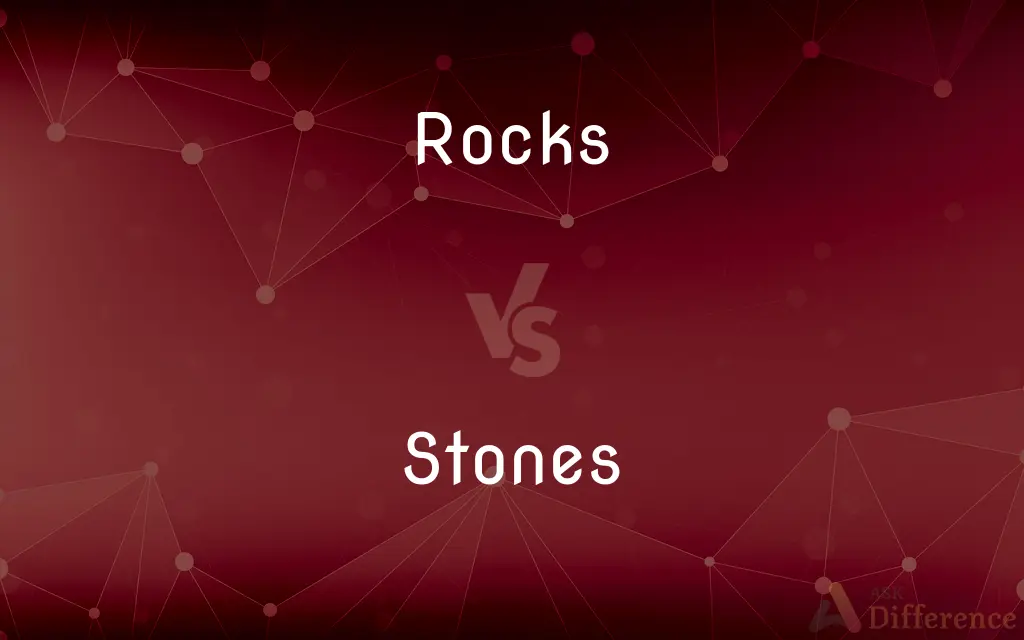Rocks vs. Stones — What's the Difference?
By Fiza Rafique & Urooj Arif — Updated on March 20, 2024
Rocks are large, natural masses of mineral material, typically found in the Earth's crust, while stones are smaller, polished pieces or fragments of rock.

Difference Between Rocks and Stones
Table of Contents
ADVERTISEMENT
Key Differences
Rocks are large, solid aggregates of minerals or mineraloids found naturally in the Earth's crust. Stones, on the other hand, are generally smaller pieces of rock that have been shaped by human or natural processes.
While rocks are often untouched and found in their natural environment, stones are typically worked or shaped in some way. Rocks can form massive structures or landscapes, such as cliffs or mountains, whereas stones are more commonly found as components of construction projects, landscaping, or as collectible items.
Rocks are essential to understanding Earth's geological history and are studied in the field of geology. Stones, while also of interest to geologists, have a more direct application in fields such as architecture, landscaping, and the arts, reflecting their modified form and utility.
Despite their differences, both rocks and stones play significant roles in Earth's ecosystem and human society. They provide essential materials for construction, art, and other human endeavors, while also offering insights into the natural processes that have shaped our planet over millions of years.
Comparison Chart
Size
Usually larger, can form massive structures
Smaller, often handheld or used for detailed work
ADVERTISEMENT
Formation
Natural processes such as volcanic activity, sedimentation
Can be natural or shaped by human or natural actions
Classification
Igneous, sedimentary, metamorphic
Classified by use or aesthetic value
Application
Studied in geology, form natural landscapes
Used in construction, art, jewelry
Human Interaction
Often found in natural state
Typically worked or shaped in some way
Compare with Definitions
Rocks
Rocks form through geological processes like cooling of magma or sedimentation.
Basalt forms from the rapid cooling of basaltic lava exposed at or very near the surface of a planet.
Stones
Stones are often collected for their aesthetic value or rarity.
Amethyst stones are collected for their beautiful purple color.
Rocks
A rock is a natural aggregate of minerals or mineraloids.
Granite is a rock composed mainly of quartz, feldspar, and mica.
Stones
Stones have been used by humans for tools and building materials throughout history.
Flint stones were used to make fire and as cutting tools in prehistoric times.
Rocks
Rocks can range from small pebbles to massive mountains.
Mount Everest, the Earth's highest mountain, consists of sedimentary and metamorphic rocks.
Stones
A stone is a small piece or fragment of a rock.
A smooth, round stone found in a riverbed.
Rocks
Rocks are studied in geology to understand Earth's history.
Geologists study rock formations to determine the age of the Earth.
Stones
Stones are often used in construction and as decorative elements.
Marble is a type of stone prized for its beauty and used in sculpture and architecture.
Rocks
Rocks are classified into igneous, sedimentary, and metamorphic.
Slate is a metamorphic rock derived from shale.
Stones
Stones are usually polished or shaped by natural or human processes.
Diamonds are stones that have been cut and polished for use in jewelry.
Rocks
Relatively hard, naturally formed mineral or petrified matter; stone.
Stones
Concreted earthy or mineral matter; rock.
Rocks
A relatively small piece or fragment of such material.
Stones
Such concreted matter of a particular type. Often used in combination
Sandstone.
Soapstone.
Rocks
A relatively large body of such material, as a cliff or peak.
Stones
A small piece of rock.
Rocks
A naturally formed aggregate of mineral matter constituting a significant part of the earth's crust.
Stones
A piece of rock that is used in construction
A coping stone.
A paving stone.
Rocks
One that is similar to or suggestive of a mass of stone in stability, firmness, or dependability
The family has been his rock during this difficult time.
Stones
A gravestone or tombstone.
Rocks
Rocks(Slang) Money.
Stones
A grindstone, millstone, or whetstone.
Rocks
(Slang) A large gem, especially a diamond.
Stones
A milestone or boundary.
Rocks
(Slang) Crack cocaine.
Stones
A gem or precious stone.
Rocks
A varicolored stick candy.
Stones
Something, such as a hailstone, resembling a stone in shape or hardness.
Rocks
Rock candy.
Stones
(Botany) The hard covering enclosing the seed in certain fruits, such as the cherry, plum, or peach.
Rocks
A rocking motion.
Stones
(Medicine) A mineral concretion in an organ, such as the kidney or gallbladder, or other body part; a calculus.
Rocks
The act of rocking.
Stones
Pl. stone Abbr. st. A unit of weight in Great Britain, 14 pounds (6.4 kilograms).
Rocks
(Music) A form of popular music characterized by electronically amplified instrumentation, a heavily accented beat, and relatively simple phrase structure. Originating in the United States in the 1950s, rock incorporates a variety of musical styles, especially rhythm and blues, country music, and gospel. Also called rock-and-roll, rock 'n' roll.
Stones
(Printing) A table with a smooth surface on which page forms are composed.
Rocks
To move back and forth or from side to side, especially gently or rhythmically.
Stones
Relating to or made of stone
A stone wall.
Rocks
To sway violently, as from a blow or shock.
Stones
Made of stoneware or earthenware.
Rocks
To be washed and panned in a cradle or in a rocker. Used of ores.
Stones
Complete; utter. Often used in combination
A stone liar.
Stone-deaf.
Rocks
(Music) To play or dance to rock music.
Stones
Completely; utterly
Stone cold.
Standing stone still.
Rocks
(Slang) To be excellent or outstanding. Used in exclamations of approval.
Stones
To remove the stones or pits from.
Rocks
To move (a child, for example) back and forth or from side to side, especially in order to soothe or lull to sleep.
Stones
To furnish, fit, pave, or line with stones.
Rocks
To cause to shake or sway violently.
Stones
To rub on or with a stone in order to polish or sharpen.
Rocks
To disturb the mental or emotional equilibrium of; upset
News of the scandal rocked the town.
Stones
(Sports) To block a shot taken by (an opponent). Used of a goalie.
Rocks
To excite or cause strong feeling in, as by playing rock music.
Stones
(Obsolete) To make hard or indifferent.
Rocks
To wash or pan (ore) in a cradle or rocker.
Stones
Plural of stone
Rocks
In mezzotint engraving, to roughen (a metal plate) with a rocker or roulette.
Stones
(slang) Testicles; balls.
Rocks
(Slang) To exhibit, display, or use with flair
The actor rocked a pair of diamond-studded sunglasses at the movie premiere.
Stones
(slang) Courage.
Rocks
Plural of rock
Rocks
(slang) Money.
Rocks
Testicles.
Rocks
(slang) Crack cocaine.
You seem a bit out of it lately, have you been smoking rocks again?
Common Curiosities
What distinguishes a rock from a stone?
A rock is a large, natural aggregate of minerals, while a stone is a smaller, often polished piece of rock.
Is granite a rock or a stone?
Granite is a type of rock that can be cut into stones for construction or decorative purposes.
How are stones used by humans?
Stones are used in construction, as decorative elements, in jewelry, and for tools.
Are all rocks the same?
No, rocks vary widely in composition and can be classified as igneous, sedimentary, or metamorphic.
Can a rock become a stone?
Yes, when a piece of rock is broken off and shaped or polished, it can be considered a stone.
Are diamonds considered stones?
Yes, diamonds are stones that have been cut and polished for use in jewelry.
What makes a stone valuable?
Factors include rarity, beauty, and utility in construction or art.
What is the significance of rocks in geology?
Rocks are crucial for understanding Earth’s geological history and processes.
Can stones be formed without human intervention?
Yes, natural processes such as erosion can shape stones.
What is the largest rock in the world?
Monoliths like Uluru (Ayers Rock) in Australia are among the largest known rocks.
Why are stones often used in landscaping?
Stones are durable, require little maintenance, and offer aesthetic appeal.
How are new rocks formed?
New rocks can form through processes like volcanic activity, sedimentation, and metamorphism.
Do all cultures use stones in the same way?
No, the use of stones varies widely among cultures, influenced by availability and tradition.
What is the difference between a pebble and a stone?
A pebble is a small, round stone, often found on beaches or in rivers.
How do rocks contribute to the Earth's ecosystem?
Rocks contribute to soil formation, provide habitats, and play a role in the carbon cycle.
Share Your Discovery

Previous Comparison
Squash vs. Racquetball
Next Comparison
Acclimatization vs. AcclimationAuthor Spotlight
Written by
Fiza RafiqueFiza Rafique is a skilled content writer at AskDifference.com, where she meticulously refines and enhances written pieces. Drawing from her vast editorial expertise, Fiza ensures clarity, accuracy, and precision in every article. Passionate about language, she continually seeks to elevate the quality of content for readers worldwide.
Co-written by
Urooj ArifUrooj is a skilled content writer at Ask Difference, known for her exceptional ability to simplify complex topics into engaging and informative content. With a passion for research and a flair for clear, concise writing, she consistently delivers articles that resonate with our diverse audience.
















































